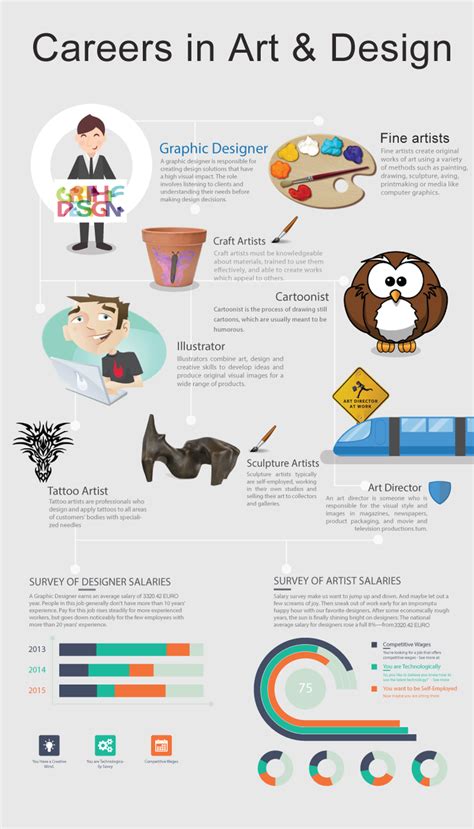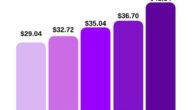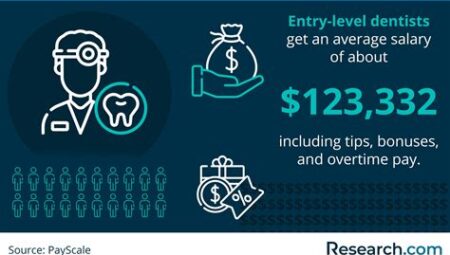Are you considering a career in graphic design? Are you curious about what kind of salary you can expect in this field? In this blog post, we will explore the world of graphic design salaries, from entry-level positions to specialized roles and even freelance opportunities. We’ll delve into the various factors that can influence your earning potential in this creative and dynamic industry, including experience, education, geographic location, and industry specialization. Whether you’re just starting out or looking to negotiate a better salary, we’ll provide you with valuable insights and tips to help you navigate your graphic design career path. So, if you’re ready to uncover the potential earnings and opportunities in graphic design, read on as we take a closer look at the artistic career path and explore the range of graphic design salaries.
Table of Contents
Understanding the Graphic Design Career Path
Graphic design is a multifaceted and dynamic field that offers a wide range of career paths for individuals with a creative and artistic flair. As a graphic designer, you have the opportunity to work in various industries, including advertising, marketing, publishing, and web design. Understanding the graphic design career path involves recognizing the different roles and responsibilities that designers can take on, as well as the skills and qualifications needed to thrive in this competitive industry.
One of the most common career paths for graphic designers is to work for a design agency or in-house design department. These positions often involve collaborating with clients to create visual concepts, developing and executing design solutions, and managing projects from conception to completion. Additionally, many graphic designers choose to freelance, allowing them to have more creative freedom and flexibility in their work. Freelancers may take on projects such as logo design, branding, and website development for a variety of clients.
Another career path within the graphic design industry is to specialize in a specific area, such as typography, illustration, or user experience design. Specializing in a niche area can lead to opportunities for higher pay and more specialized roles within the industry. Furthermore, some experienced graphic designers choose to transition into art direction or creative direction, where they oversee the visual aspects of a project and lead a team of designers to achieve a cohesive and impactful design.
As a graphic designer, it’s crucial to stay up-to-date with the latest design trends, software, and technologies to remain competitive in the field. Continuous learning and professional development are essential for advancement in the graphic design career path, whether through pursuing additional education, attending workshops and conferences, or networking with other professionals in the industry.
Factors that Influence Graphic Design Salaries
When it comes to graphic design salaries, there are several factors that play a key role in determining how much a designer earns. One of the most significant factors is the level of experience the designer has in the field. Designers with several years of experience typically command higher salaries compared to entry-level designers.
Another important factor that influences graphic design salaries is the geographic location of the designer. Designers working in major metropolitan areas or in areas with a high cost of living tend to earn higher salaries compared to those working in smaller cities or rural areas.
Education level and type of specialization are also key factors in determining graphic design salaries. Designers with advanced degrees or specialized skills in areas such as web design or UX/UI design may earn higher salaries compared to those with only a basic education in graphic design.
Additionally, the industry in which a designer works can have a significant impact on their salary. For example, designers working in the advertising or marketing industry may earn higher salaries compared to those working in non-profit organizations or government agencies.
Exploring Entry-Level Graphic Design Salaries
Entry-level graphic design salaries are an important consideration for aspiring designers as they embark on their careers in the industry. These salaries are influenced by a variety of factors, including education, experience, geographic location, and industry specialization. Understanding the dynamics of entry-level graphic design salaries is crucial for individuals seeking to enter this competitive field.
One of the key factors that impact entry-level graphic design salaries is education. Designers with a formal education, such as a degree in graphic design or a related field, may command higher starting salaries compared to those with only self-taught skills or a certificate program. Additionally, individuals with a strong portfolio and relevant internships may also have an advantage in negotiating entry-level salaries.
Another influential factor is geographic location. Entry-level graphic design salaries can vary significantly from one city to another, with metropolitan areas often offering higher starting salaries compared to smaller towns or rural areas. Cost of living, demand for designers, and local industry trends all play a role in determining entry-level salaries in different locations.
Furthermore, industry specialization can have a significant impact on entry-level graphic design salaries. Designers who choose to focus on lucrative industries such as technology, healthcare, or finance may command higher starting salaries compared to those working in non-profit or government sectors.
How Experience Impacts Graphic Design Salaries
Experience plays a crucial role in determining the graphic design salaries. As designers gain more experience in the field, they often see a steady increase in their earning potential. With experience comes knowledge and expertise, which are highly valued in the graphic design industry.
Employers are more willing to invest in designers with a proven track record of successful projects and a deep understanding of design principles. This often translates to higher pay and better job opportunities for experienced graphic designers.
Additionally, experienced designers are often entrusted with more complex and high-profile projects, which can also contribute to higher salaries. Their ability to efficiently and creatively solve design challenges makes them invaluable assets to their employers, leading to increased compensation.
In conclusion, the impact of experience on graphic design salaries cannot be overstated. As designers continue to hone their skills and accumulate valuable experience, they are well-positioned to command higher earnings and advance their careers in the graphic design industry.
The Role of Education in Graphic Design Salaries
When considering a career in graphic design, it’s important to understand how education can impact your potential salary. Many aspiring graphic designers wonder if a degree is necessary, and if so, how much it can influence their earning potential.
While it’s true that some graphic designers are self-taught and have found success without a formal education, having a degree in graphic design or a related field can often lead to higher starting salaries and more opportunities for advancement. Employers may place a higher value on candidates with a degree, as it demonstrates a commitment to the field and a certain level of expertise.
Specialized education, such as a master’s degree or certification in a specific area of graphic design, can also lead to higher salaries. Many employers are willing to pay more for designers who have advanced skills and knowledge in areas such as web design, user experience, or branding.
Overall, while education is not the only factor that influences graphic design salaries, it can play a significant role in determining earning potential and career opportunities.
Analyzing Geographic Location and Graphic Design Salaries
When it comes to graphic design salaries, geographic location plays a significant role in determining how much a designer can expect to earn. In major cities with a high cost of living, such as New York or San Francisco, graphic designers tend to command higher salaries compared to those working in smaller cities or rural areas.
However, it’s not just about the cost of living. The demand for graphic designers can also vary greatly from one location to another. For example, urban centers with a thriving creative industry are more likely to have a higher demand for graphic designers, leading to increased competition and potentially higher salaries.
On the other hand, in areas where the demand for graphic designers is lower, individuals may find that the average salary is also lower. This can be particularly challenging for designers who prefer to live in more rural or less densely populated areas.
Ultimately, it’s important for graphic designers to carefully consider the geographic location in which they plan to work. While a higher salary may be appealing, it’s essential to weigh the cost of living and demand for the profession in that particular area.
Unveiling the Influence of Industry on Graphic Design Salaries
When it comes to graphic design salaries, the industry in which a designer works can have a significant impact. Different industries have varying levels of demand for graphic design services, and this can directly affect the salaries offered to designers. For example, working in the advertising or marketing industry may offer higher salaries compared to working in the publishing or non-profit sector.
Furthermore, the specific demands and requirements of different industries can also influence graphic design salaries. For instance, industries that require specialized skills such as web design, user interface design, or branding may offer higher salaries to designers with expertise in these areas. On the other hand, industries with less emphasis on design may offer lower salaries due to lower demand and perceived importance of design services.
In addition to demand and specific skill requirements, the size and financial health of the industry can also play a role in determining graphic design salaries. Designers working in large, financially prosperous industries might find themselves commanding higher salaries compared to those working for smaller or less financially stable companies.
Overall, understanding the influence of industry on graphic design salaries is crucial for designers looking to negotiate better pay or make informed decisions about their career paths. By recognizing the factors that contribute to salary discrepancies across industries, designers can strategically position themselves for higher earning potential and professional growth.
Specializations and their Impact on Graphic Design Salaries
When it comes to graphic design careers, there are various specializations that can have a significant impact on salaries. For instance, web designers who specialize in creating user-friendly websites and online platforms can often command higher salaries than general graphic designers. This is due to the technical skill set and specialized knowledge required for web design projects.
Similarly, UX/UI designers who focus on creating seamless and intuitive user experiences for digital products and applications are in high demand, leading to higher earning potential. On the other hand, branding and identity designers who specialize in developing visual identities and branding strategies for businesses may also see higher salaries due to the strategic nature of their work and the impact it has on a company’s success.
It’s important for aspiring graphic designers to consider the various specializations within the field and understand how each can impact earning potential. By honing skills in a specific area of graphic design, professionals can position themselves for higher salaries and more competitive opportunities in the job market.
Ultimately, the choice of specialization within graphic design can have a significant influence on salaries, making it crucial for individuals to carefully consider their career path and the potential financial rewards of pursuing different areas of expertise.
Freelance Graphic Designers: Pros and Cons of Earnings
Freelance graphic design offers a unique set of advantages and disadvantages when it comes to earnings. One of the main pros of freelance graphic design is the potential for higher income. As a freelancer, you have the ability to set your own rates and take on as much work as you can handle, allowing for the potential to earn more than you would in a traditional full-time position.
On the other hand, one of the cons of freelance graphic design earnings is the lack of stability. Unlike a full-time job, where you receive a regular paycheck, freelance income can fluctuate greatly from month to month. This inconsistency can make it challenging to budget and plan for the future.
Another benefit of freelance graphic design earnings is the potential for more flexibility. As a freelancer, you have the ability to choose your own projects and work schedule, allowing for a better work-life balance. This flexibility can be especially appealing for those who value autonomy and independence.
However, a potential downside to freelance graphic design earnings is the need to handle administrative tasks. As a freelance designer, you are responsible for invoicing, managing expenses, and handling taxes. This added administrative burden can be time-consuming and take away from time that could be spent on actual design work.
Tips for Negotiating Better Graphic Design Salaries
As a graphic designer, negotiating a better salary can be a daunting task, but it is essential to ensure that your skills and expertise are properly compensated. One tip for negotiating better graphic design salaries is to research industry standards and average salaries for your level of experience and expertise. By having a clear understanding of what other graphic designers are earning, you can confidently negotiate for a fair compensation package.
Another tip for negotiating better graphic design salaries is to highlight your unique skills and contributions to potential employers. Whether it’s a specific design technique, software proficiency, or a successful project you’ve worked on, showcasing your value can give you leverage during salary negotiations.
It’s also important to be prepared to discuss your potential for growth and development within the company. By demonstrating your willingness to learn and take on additional responsibilities, you can make a strong case for a higher salary. Additionally, being open to discussing benefits such as remote work opportunities, professional development opportunities, or flexible scheduling can also contribute to a more favorable compensation package.
Finally, it’s crucial to approach salary negotiations with confidence and professionalism. Be prepared to advocate for yourself and your worth, and don’t be afraid to ask for what you deserve. Remember that negotiating a better graphic design salary is not only about the numbers, but also about positioning yourself as a valuable asset to the company.






